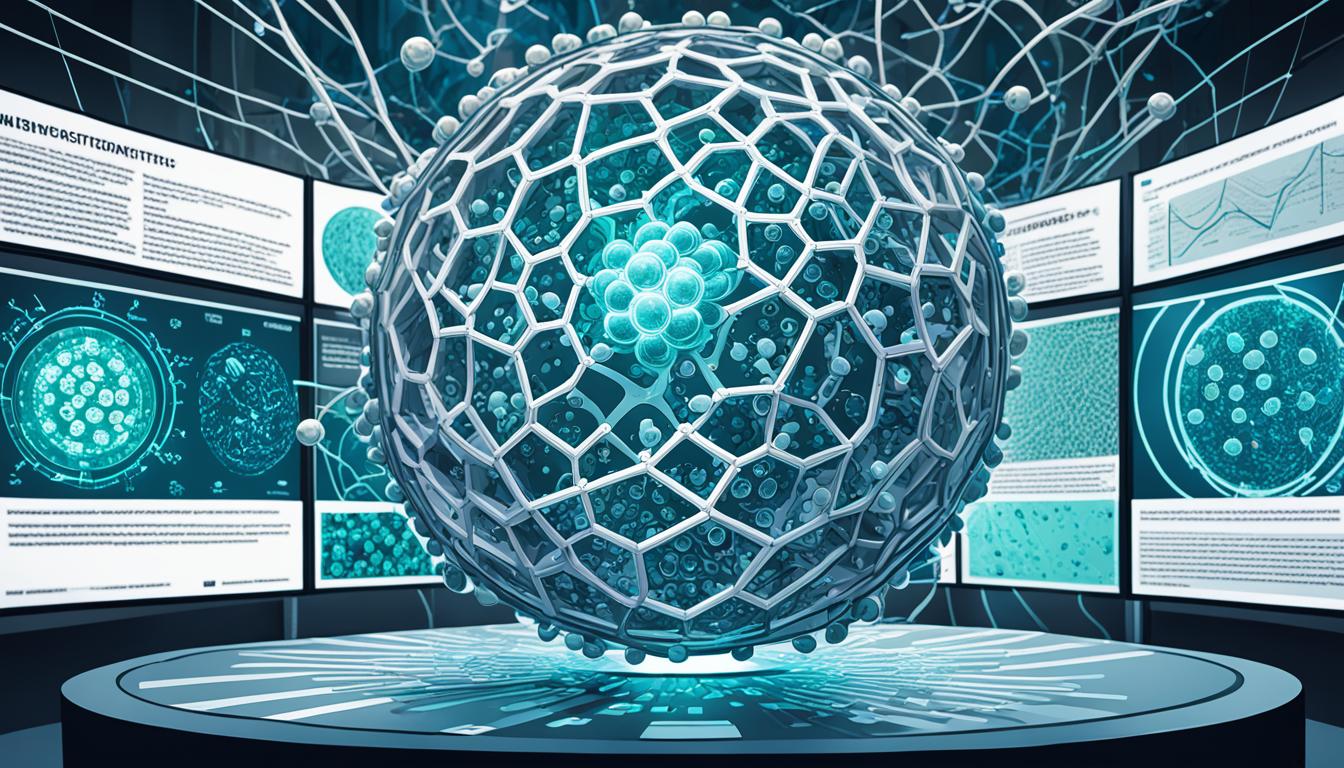Imagine a world where the secrets of protein structures are easily revealed. A place where drug development is precise and within reach. MIT’s advancements make this future possible now.
Finding effective treatments is tough due to complex protein structures. Before, researchers spent lots of money and time on experiments to understand these proteins.
At MIT, a group led by Gabriele Corso and Hannes Stärk uses AI to decode proteins efficiently. Their machine learning model changes the game in drug development.
They created a tool that accurately predicts protein positions, far better than old methods. This tool’s success rate is impressive, beating traditional models by a large margin1.
This technology allows much of drug discovery to happen on computers1. It speeds up the process considerably. Now, researchers can find drug targets in a day instead of years.
What makes this AI unique? Corso and Stärk’s model can guess many outcomes, not just one1. This flexibility means it can handle uncertainty well, making better predictions.
Mit’s AI model is a big leap in understanding drugs and proteins. It opens new paths for creating medicines and exploring how cells work.
Scientists can now explore how drugs work with proteins more deeply. This leads to safer, more effective medicines. It marks progress in medical science and could help millions.
Key Takeaways:
- MIT researchers have developed an advanced machine learning model that uses AI to decode protein structures.
- DiffDock’s “blind docking” approach surpasses traditional models in accuracy, reaching 22% precision within 2 angstroms.
- The use of DiffDock in the drug discovery process saves significant time and costs, allowing for virtual drug target identification and mechanism of action characterization in just a day.
- DiffDock’s generative modeling approach enables multiple predictions, avoiding the limitation of searching for a single right answer and improving outcomes in the face of uncertainty1.
Understanding the Importance of Condensates in Drug Concentration
Condensates are special cell areas without membranes that form from tangled molecules. They turn into droplets inside cells, creating spaces for important molecular gatherings and functions2. Studies show that drugs can pile up in these condensates. This affects how well the drugs work3. By studying these condensates, scientists can pinpoint where in the cell a drug will go. This helps them make better drugs2. Knowing all about this is crucial for crafting drugs that are safe and hit their target precisely, especially in the condensates3.
The amount of drug in condensates depends on how molecules inside these spaces interact. The drug’s physical traits and what the condensate is made of play roles too2. Knowing about these interactions is key to understanding how drugs work inside cells. By making drugs that gather in the right condensates, scientists can make treatments more effective and reduce unwanted side effects3.
In one MIT study, researchers looked at where FDA-approved drugs ended up inside cells. They found these drugs don’t always go where expected3. For drugs to work well and be safe, they should gather where their target protein is3. This research stresses the need to think about where drugs collect in cells when designing them for the best results3.
Teams of AI experts and biotech firms, like Dewpoint, are working together. They use artificial intelligence to better understand how cells work and what goes wrong3. This team effort brings together knowledge from biology, chemistry, physics, and AI. They aim to get new insights into how drug concentration in cells can be improved3. This could lead to more effective treatments for many diseases3.
The study of condensates in drug concentration is giving new directions for drug creation and how to make them target cells more accurately. By looking closer at how drugs interact within condensates, scientists hope to enhance the effectiveness of drugs. This could lead to better treatments and safer medications for patients.
Predicting Drug Concentration in Condensates Using Machine Learning
MIT researchers are using machine learning to find drug concentrations in cellular condensates. This helps make drugs more effective and reduces side effects. They’re combining AI’s power with targeted treatments for better results.
They looked at how drugs pile up in cell compartments. The team noticed that drugs tend to gather in certain areas4.This discovery led them to study condensates’ role in drug localization.
The team tested over 1500 molecules across three condensate types: transcriptional, gene repression, and nucleolus4. Using machine learning, they figured out patterns that predict where drugs concentrate. This method could change how we predict drug locations based on their chemical structures.
Their machine learning model did well in predicting condensate drug levels. It even had some success with live cells4. This shows how complex the cellular world is, with many proteins changing the chemical scene.
They found that transcriptional condensates attract molecules with electron-rich rings4. This helps in designing better drugs and targeting them more effectively.
The Significance of Cellular Organization and Drug Concentration
This research shows how key it is to understand cell organization and drug concentration. Knowing about the proteins in cells can improve drug prediction models4. This could help make better drugs with fewer side effects.
It also shows the vital role of condensates in how drugs work and are developed. Understanding condensates’ chemistry is crucial for biology and finding new drugs4.
Implications for Drug Developers and Cellular Processes
The MIT team’s work could really help those making drugs and studying cell processes. Knowing how to predict drug levels in cells means better drug designs. This can make treatments more effective and safer4.
Last, understanding proteins’ physical and chemical traits can lead to better therapies. Controlling drug levels in cells could improve patient outcomes and cut down on side effects4.
AI Designing Novel Proteins with Specific Structural Features
MIT experts are pushing the boundaries of protein design using AI, focusing on creating proteins with unique structures5. They use advanced machine learning to predict amino acid sequences that achieve specific goals. Their work could lead to new materials that are not only effective but also environmentally friendly.
This approach in protein design is highly productive. In a few days, millions of new proteins can be made5. These creations closely match up to 60 percent of existing proteins5.
Even with ambitious goals, the AI models reliably produce realistic solutions5.
The team developed two kinds of models for detailed protein design5. This gives them precise control over the protein’s structure.
They also linked these models to an algorithm that predicts how a protein folds5. This connection helps in checking if the protein meets design criteria.
This pioneering work is supported by top organizations like the MIT-IBM Watson AI Lab and the U.S. Department of Energy5.

| Advantages of AI Protein Design | References |
|---|---|
| 1. Rapid generation of millions of novel proteins with specific structural features | 5 |
| 2. High overlap between newly designed and existing amino acid sequences, indicating synthesizability | 5 |
| 3. Production of realistic and probable solutions for physically impossible design targets | 5 |
| 4. Fine-grained control in protein design at both overall structural and amino acid levels | 5 |
| 5. Integration with protein folding algorithm for property determination and optimization | 5 |
Smoothing the Protein Fitness Landscape for Optimization
To make protein fitness better, MIT scientists suggest using graph methods to smooth the landscape. This makes finding better proteins easier and quicker. It helps find new proteins with enhanced fitness for certain traits.
They created a method called Gibbs sampling with Graph-based Smoothing (GGS). It smooths the fitness landscape and uses Gibbs sampling for top-notch outcomes6. This could change how we engineer proteins.

Imagine the protein landscape as complex ground with high and low spots. High points mean good fitness and low points mean poor. Traditional methods struggle because the landscape is rough and noisy. But, smoothing it removes small bumps, making optimizing easier.
GGS uses graph smoothing to make the landscape less noisy. It looks at nearby points to help find the best protein sequences6. This makes it easier to spot sequences with better fitness.
By adding Gibbs sampling, GGS explores many possible sequences at once. This broad search helps find really good sequences that other methods might miss6.
Using GGS has given better results in making proteins better. It has beaten earlier methods and improved the fitness for various protein features6. This could help in many areas, like medicine, bioengineering, and making new biological systems.
GGS shows how using machine learning and optimization can improve protein engineering. With computers and statistics, scientists can better understand the complex protein fitness landscape. This speeds up making new proteins with the traits we want.
Advancing Protein Optimization with Graph-Based Smoothing
Protein optimization is vital in fields like biotech and pharma. Scientists at MIT developed a method called Graph-based Smoothing (GGS)7. This method blends Gibbs sampling with graph signal processing to smooth the fitness landscape. It makes protein optimization algorithms work better.
Using GGS led to a 2.5 times improvement in fitness for the studied proteins7. It boosted performance in GFP benchmarks, raising fitness from 18% to 39%. Likewise, in AAV benchmarks, fitness jumped from 4% to 44%7. These gains show GGS as a top-notch method, outdoing other techniques in both GFP and AAV.
GGS does well because it uses a smooth energy function7. But, it’s not perfect for all optimization issues. Still, when combined with other methods like GWG, GGS gives excellent results in many situations7.
Turning fitness data into a form optimization algorithms can use is critical. Regularization helps sort out noisy fitness landscapes. This makes sure the algorithms work right7.
GGS’s use in protein optimization is a big step forward. It helps find high-quality proteins. Combining Gibbs sampling with graph-based smoothing opens up new ways to design and improve proteins7.
Graph-Based Smoothing in Protein Optimization
Graph-based smoothing has changed protein optimization. MIT researchers used it to estimate fitness landscapes from initial data8. The model they built can guess the rest of the landscape, making it easier to optimize proteins8.
They trained the model with data from about 1,000 green fluorescent protein (GFP) variants8. A CNN model helped predict optimized GFP sequences. These turned out to be 2.5 times fitter than the originals8.
This smoothing method also helped find new sequences for AAV viral capsids. Such advancements support industries like biotech and pharma in engineering proteins with specific roles8.
Advancements in Protein Optimization Models
Recent models like Chroma, RF Diffusion, and ESM-2 showcase progress in protein design. The RF Diffusion model, from the Baker Lab and MIT, created 1,000 protein designs9. ESM-2, by Meta AI FAIR, sets new records and helps with protein forms without needing Multiple Sequence Alignments9. Liu et al.’s MoleculeSTM even lets users edit molecular graphs based on descriptions9.
Such models can generate protein sequences and structures at the same time. ProtSEED, by Shi et al., works well in various design tasks9. Inverse folding models are also evolving, helping create sequences from structures9.
Machine learning is enhancing molecular dynamics and discovery too. GNNs have made a big difference in efficiency and accuracy. In addition, ML models like GraphCast by DeepMind and Pangu-Weather by Huawei are improving weather forecasting, beating traditional methods with quicker and more accurate predictions9.
Conclusion
MIT’s research is changing the pharmaceutical world. Their work in protein engineering is leading to new drugs and materials. They’re using machine learning to change how we see proteins. This could make drugs better and cheaper while bringing new therapies.
10Thanks to cryo-electron microscopy, scientists can now see proteins like never before. This shows how proteins look in 3D. MIT’s algorithms use this data to predict various protein structures. This is key in protein science. Their AI software can find all possible structures quickly, making protein analysis faster.
MIT’s work on ribosome assembly has shown how effective their methods are. They discovered a new ribosomal state. This could lead to new drugs and teaches us about cell functions.
This research doesn’t just impact protein engineering. It’s also making drug development faster and more affordable. Techniques like DiffDock are making it easier to find drug targets. Funding from the National Science Foundation, the National Institutes of Health, and others shows the value of MIT’s work11.










